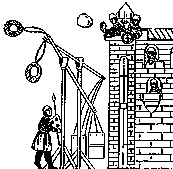
If you are looking at this page without frames, there is more information about medieval writing to be found by going to the home page (framed) or the site map (no frames).
| Works on Science (3) | |||
 |
Much can be learned about many aspects of medieval technology from manuscript sources, but not necessarily from sources devoted to describing or explaining the technology. Depictions of warfare in manuscript miniatures from chronicles or romances have provided information on machines of war such as the trebuchet, and have provided sufficient information to allow such contraptions to be reconstructed as working models. | ||
| The trebuchet | |||
| The depiction of agricultural scenes in the miniatures or marginalia of manuscripts with a diversity of subject matter, even psalters or books of hours, illustrate all kinds of agricultural technology, such as mills or ploughs. | |||
| Images of a plough and a mill from the 14th century Luttrell Psalter (British Library add. ms. 42, 130, ff. 170 and 158). | |||
| The very rich imagery of this particular manuscript has been used to illustrate many aspects of English rural life if the 14th century, including a large array of agricultural technologies. | |||
| Woman weaving in a 14th century manuscript of Pictorial Illustrations to the Book of Genesis (British Library, Egerton 1894, f.2v). | |||
| Industrial technology was also illustrated in striking detail in unexpected contexts. In the medieval convention, there is no attempt to show weaving technology from the days of the Biblical Book of Genesis. Such things were illustrated in contemporary mode. From various manuscript sources, it is possible to obtain depictions of the technology of building, shipping and a whole lot of other things if you look in the right places. | |||
| Various types of scientific instruments appeared in the later middle ages as science started to become more mechanical. Treatises on optics led to the development of magnifying lenses. Mechanical clocks measured time. The astrolabe was a device known in antiquity; a gadget with various plates and wheels which allowed calculations to be made from observations of the night sky. It is interesting that Geoffrey Chaucer wrote, translated or republished a treatise on this instrument, indicating that such scientific wonders were no longer the preserve of learned Latin readers in monasteries or universities, but were of interest to lay, vernacular readers. | |||
| The text of A Treatise on the Astrolabe can be obtained from Fordham University. An exhibition Epact: Scientific Instruments of Medieval and Renaissance Europe shows some of these and other newfangled scientific instruments of the late medieval and Renaissance period. | |||
| A discussion of medieval scientific literacy can therefore get tangled up in matters of definition. While there were many things that they simply did not know, there were also things that they did know. Superstition and fear did not prevent them from knowing things. But knowledge obtained from what we now call the scientific method was not placed in a separate category or given precedence over knowledge obtained by other means, whether religious teaching or the the weight of antiquity behind thoughts and writings that had been handed down through generations of scholars. They also had a great deal of practical scientific knowledge that was not preserved in the literate mode. How did they know that a flying buttress would work when Newton had not yet even been donged on the head by that apple? | |||
| Two websites that provide introductions to these topics are The Medieval Science Page and the Medieval Technology Pages. Unfortunately, neither has been updated for a very long time, so their links may be rather out of date. | |||
| |
|||
|
If you are looking at this page without frames, there is more information about medieval writing to be found by going to the home page (framed) or the site map (no frames). |
|||